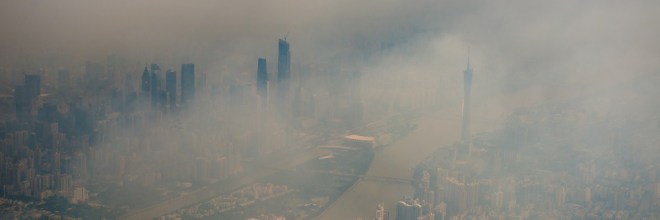Despite a decrease in US air pollution production, smog levels are still on the rise in the western part of the country, and now new research has found that an influx of impurities originating from Asia has been making its way across the Pacific Ocean and might be to blame.
The study, which was led by scientists from Princeton University and the National Oceanic and Atmospheric Administration‘s Geophysical Fluid Dynamics Laboratory and published last week in the journal Atmospheric Chemistry and Physics, found that Asian air pollution contributed up to two-thirds of increasing western ozone in recent years, according to NPR reports.
Lead author Meiyun Lin, a scientist at GFDL and a research scholar at Princeton’s atmospheric and oceanic sciences department, and her colleagues found that ozone levels measured in rural areas of the west have increased over the past 25 years, even though there has been a 50 percent reduction in local production of smog-forming chemicals such as nitrogen oxides (NOx).
Further analysis traced the increase in ozone in the western US to pollution from China, North Korea, South Korea, Japan, India and other South Asian nations. Collectively, NOx emissions in this region have more than tripled since 1990, the study authors explained in a statement.
“Increasing background ozone from rising Asian emissions leaves less room for local production of ozone before the federal standard is violated,” said Lin. She and her colleagues noted that their study underscores the importance of continuing domestic policies governing emissions given off by motor vehicles and power plants while also taking a globalized approach to air quality.
Eastern US ozone expected to worsen due to climate change
Lin’s team discovered the decrease in pollution in the western US and the increases from Asian sources while analyzing the sources of smog, also known as ground-level ozone, from the 1980s through 2014. Their findings explain why springtime ozone levels in Yellowstone National Park and other nearby parks have increased over the past 25 years, they said.
In fact, their study found a “significant” increase in springtime ozone levels of 5 to 10 parts per billion. Since smog is hazardous to human health, especially for those with asthma or other types of respiratory problems, and can harm some trees and crops, federal regulations require that these emissions be capped at 70 ppb. Increases in Asian pollution could make that difficult.
“Twenty years ago scientists first speculated that rising Asian emissions would one day offset some of the United States’ domestic ozone reductions,” said Owen Cooper, a senior researcher at the University of Colorado and the NOAA Earth System Research Laboratory who was familiar with the study but was not one of its authors. “This study takes advantage of more than 25 years of observations… to comprehensively demonstrate that these early predictions were right.”
The study also found that while smog levels in the eastern US had fallen over the past quarter-century, ozone levels in this part of the country can rise during increasingly common heat waves. However, since periods of extreme heat and drought can trap pollution, and because these events are expected to become more common, the study predicts that smog in the eastern US will likely worsen in the near future.
—–
Image credit: Thinkstock



Comments